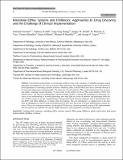| dc.contributor.author | Kourtesi, Christina | |
| dc.contributor.author | Ball, Anthony R. | |
| dc.contributor.author | Huang, Ying-Ying | |
| dc.contributor.author | Jachak, Sanjay M. | |
| dc.contributor.author | Vera, D. Mariano A. | |
| dc.contributor.author | Khondkar, Proma | |
| dc.contributor.author | Gibbons, Simon | |
| dc.contributor.author | Hamblin, Michael R. | |
| dc.contributor.author | Tegos, George P. | |
| dc.date.accessioned | 2013-11-15T18:38:37Z | |
| dc.date.available | 2013-11-15T18:38:37Z | |
| dc.date.issued | 2013-03 | |
| dc.date.submitted | 2013-01 | |
| dc.identifier.issn | 18742858 | |
| dc.identifier.uri | http://hdl.handle.net/1721.1/82136 | |
| dc.description.abstract | Conventional antimicrobials are increasingly ineffective due to the emergence of multidrug-resistance among pathogenic microorganisms. The need to overcome these deficiencies has triggered exploration for novel and unconven-tional approaches to controlling microbial infections. Multidrug efflux systems (MES) have been a profound obstacle in the successful deployment of antimicrobials. The discovery of small molecule efflux system blockers has been an active and rapidly expanding research discipline. A major theme in this platform involves efflux pump inhibitors (EPIs) from natural sources. The discovery methodologies and the available number of natural EPI-chemotypes are increasing. Advances in our understanding of microbial physiology have shed light on a series of pathways and phenotypes where the role of efflux systems is pivotal. Complementing existing antimicrobial discovery platforms such as photodynamic therapy (PDT) with efflux inhibition is a subject under investigation. This core information is a stepping stone in the challenge of highlighting an effective drug development path for EPIs since the puzzle of clinical implementation remains unsolved. This review summarizes advances in the path of EPI discovery, discusses potential avenues of EPI implementation and development, and underlines the need for highly informative and comprehensive translational approaches. | en_US |
| dc.description.sponsorship | National Institutes of Health (U.S.) (R01AI050875) | en_US |
| dc.description.sponsorship | United States. Air Force (MFEL Program FA9550-04-1-0079) | en_US |
| dc.language.iso | en_US | |
| dc.publisher | Bentham Science | en_US |
| dc.relation.isversionof | http://dx.doi.org/10.2174/1874285801307010034 | en_US |
| dc.rights.uri | http://creativecommons.org/licenses/ by-nc/3.0/ | en_US |
| dc.source | PMC | en_US |
| dc.title | Microbial Efflux Systems and Inhibitors: Approaches to Drug Discovery and the Challenge of Clinical Implementation | en_US |
| dc.type | Article | en_US |
| dc.identifier.citation | Kourtesi, Christina. “Microbial Efflux Systems and Inhibitors: Approaches to Drug Discovery and the Challenge of Clinical Implementation.” The Open Microbiology Journal 7, no. 1 (March 29, 2013): 34-52. | en_US |
| dc.contributor.department | Harvard University--MIT Division of Health Sciences and Technology | en_US |
| dc.contributor.mitauthor | Hamblin, Michael R. | en_US |
| dc.relation.journal | The Open Microbiology Journal | en_US |
| dc.eprint.version | Final published version | en_US |
| dc.type.uri | http://purl.org/eprint/type/JournalArticle | en_US |
| eprint.status | http://purl.org/eprint/status/PeerReviewed | en_US |
| dspace.orderedauthors | Kourtesi, Christina; Ball, Anthony R.; Huang, Ying-Ying; Jachak, Sanjay M.; Vera, D. Mariano A.; Khondkar, Proma; Hamblin, Michael R.; Tegos, George P. | en_US |
| mit.license | PUBLISHER_CC | en_US |
| mit.metadata.status | Complete | |
